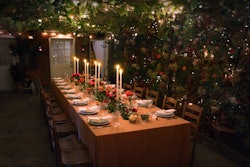
If the last two years have taught us anything, it’s that connection and community are some of the key aspects of any event. So perhaps it's not surprising that as in-person gatherings return, brands and event hosts are often turning to intimate dinner parties to help guests get reconnected and to facilitate networking.
So, how can you curate your guest list, decor and conversation topics with this goal in mind? We asked some experts for their top tips.
1. Start by identifying your event's main theme and goal—and build your guest list from there.
Like with any event, it’s crucial to identify your goal for the gathering—and when appropriate, build the theme around it. Once you have that, you can curate your guest list in service of the event’s goals.
“When curating an authentic theme with the goal in mind, the guest list should also be considered within these perimeters,” explains Christy Bareijsza, founder and creative director at By Red Carpet Events. “Based on the goal being obtained, the group size and demographic can be uniquely different, as a small modification can change the overall experience dramatically by creating imbalance.”
Byron Regej, founder and chief creative officer at Regej & Company, also likes to curate a guest list based on an overall theme. “Having the right mix from different industries—with a common thread—is important,” he notes.
2. Keep your guest counts small.
Most banquet tables seat eight to 10 guests—and there’s a reason for that, notes Bareijsza. “That headcount is ideal to spark an engaging conversation. Less than eight seated guests tends to impede on the delicate balance of extroverts wanting to lead the conversation, combined with gently forcing the introverts to gain a level of comfort to willfully engage in the banter.”
Regej also recommends seating no more than eight to 12 people per table—but notes that number can be flexible if having a slightly larger group ties into the event’s look, feel and goals. At a recent industry dinner he hosted in a Hollywood Hills home, for example, the team opted for a smaller, more curated group in order to have one communal table—a format that worked best for that unique setting.
3. Be strategic with your seating chart.
A carefully thought-out seating charge can also help facilitate conversation. Regej refers to this as a “strategic process. Having worked on many industry dinners over my career, specifically at Condé Nast where fashion had to meet luxury advertisers, the key is the right connection left and right and across the table,” he explains. “We want to encourage cross-pollination of conversation with like-minded people—but from different backgrounds.”
Take into account the different personalities too—consider balancing out the larger personalities with the introverts to help encourage the conversation flow. “It has to be strategically done to ensure there is a connection that leads to conversation at the table,” adds Regej. “We look at [an attendee’s] background and match that with like-minded people who may be in a different industry, but who can relate to cultural and industry nuances.”
But keep in mind that seating charts aren’t always the right choice. “At an intimate dinner, seating charts can lead to a competitive environment—[they] can dictate favoritism or seniority based on table position,” points out Bareijsza. “It’s often less provoking to allow guests to choose their own seats—unless, of course, you want to engage in positioning or have a message to be shared during dinner that will require the full table’s attention.”
4. Think carefully about your host.
Regardless of whether your event has formal talking points or a formal seating chart, it’s typically a good idea to have someone in that “host” role, who can be responsible for keeping guests engaged and comfortable—and who can jump in if there are silences or if guests need help introducing themselves.
“A good host is someone who speaks from the heart, and is conversational and relatable to the people attending,” says Regej, who adds that at his recent intimate dinner, the team also “had curated quotes on each person's menu that were great ice breakers and induced conversation.”
Whether conversation topics should be preplanned or more informal depends, again, on your event’s goals. At BizBash, for example, we’re currently hosting a series of intimate Jeffersonian Dinners around the country this year, with the goal of bringing event professionals together to discuss the state of the industry. Named for Thomas Jefferson, who was known for holding intimate dinner parties that resulted in insightful, thought-provoking conversations, the event format sees the entire table discussing one topic, led by a host, rather than guests having their own conversation with seatmates. (Learn more in our GatherGeeks podcast on the topic.)
If the event’s goal is geared more towards networking, though, Bareijsza finds that icebreakers or preplanned topics can sometimes lead to awkward or guarded responses. Her suggestion to draw authentic conversations? “Building an activity around the icebreaker, like a wine tasting or cooking experience, will help to give a more genuine introduction. The best way to have guests participate and engage is to remain authentic with questions asked, give eye contact—and of course, have an incredible bartender!” she says.
5. Decor can be used to spark conversation.
As any event professional knows, decor is a crucial aspect of any event. At an intimate event or dinner party intended to facilitate conversation and connections, it can be even more important.
“Decor is extremely important as it will enhance the request to network,” points out Bareijsza. “Whether it’s a style (or comfort) of seating, room placement of the food and beverage, or full sensory, strategically placed conversation pieces, ... the decor can truly enhance and facilitate the ability to mingle and converse with the invited guests.”
Part of that is making sure your decor choices never take away from the ability to have conversations. For seated dinners, avoid super-wide tables, and make sure centerpieces are either below or above the sight line, so guests can talk throughout the meal. Lighting should be dim enough to be flattering, but bright enough that guests can see each other across the table, while any music or other entertainment should provide ambient noise but not impede conversations.
And pay attention to the first impression guests get when they walk in, suggests Regej. “For me, the first impression is the most important of any successful experience. It's the immediate reputation of that brand or individual and what they stand for, and it sets a benchmark for what to expect.”
Keep that overall event theme or goal in mind when designing every aspect of the gathering. “[The event] has to have a narrative, a POV and a story,” says Regej. “There is an overall theme for the event, which we sprinkle through save-the-dates and official invites, and then in subtle brand touchpoints like the dinner setting placement with a quote, to the personalized handwritten notes in gift bags. Each item is carefully curated, and has a purpose for existing.”



















